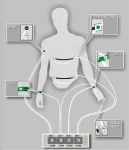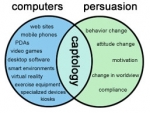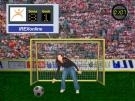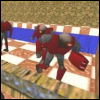Mar 31, 2005
Biofeedback - improve health using signals from your own body
Biofeedback is a treatment technique in which people are trained to improve their health
by using signals from their own bodies. Physical therapists use biofeedback to help stroke
victims regain movement in paralyzed muscles. Psychologists use it to help tense and
anxious clients learn to relax. Specialists in many different fields use biofeedback to help
their patients cope with pain.
 Research has demonstrated that biofeedback can help in the treatment of many diseases and painful conditions. It has shown that we have more control over so-called involuntary bodily function than we once though possible. But it has also shown that nature limits the extent of such control. Scientists are now trying to determine just how much voluntary control we can exert.
Research has demonstrated that biofeedback can help in the treatment of many diseases and painful conditions. It has shown that we have more control over so-called involuntary bodily function than we once though possible. But it has also shown that nature limits the extent of such control. Scientists are now trying to determine just how much voluntary control we can exert.
Clinical biofeedback techniques that grew out of the early laboratory procedures are now
widely used to treat an ever-lengthening list of conditions. These include:
·Migraine headaches, tension headaches, and many other types of pain
·Disorders of the digestive system
·High blood pressure and its opposite, low blood pressure
·Cardiac arrhythmias (abnormalities, sometimes dangerous, in the rhythm of the heartbeat)
·Raynaud's disease (a circulatory disorder that causes uncomfortably cold hands)
·Epilepsy
·Paralysis and other movement disorders
Low-cost biofeedback devices and products
ProComp Infiniti
Powerful 8 channel encoder provides real-time biofeedback and data acquisition in any clinical setting.

The Journey to Wild Divine
Learn to relax while playing this immersive new biofeedback videogame. Take a deep breath...

RESPeRATE
RESPeRATE is the only FDA-cleared, non-drug, medical device clinically proven to lower high blood pressure with no side effects.

Freeze-Framer
You'll appreciate all you can learn about the power of your heart. It's also just plain fun to play the games while you learn.

Mini C2+
This tiny 6 channel unit is an affordable, powerful multi-modality biofeedback system.

More to explore
Biofeedback Foundation of Europe
The Association for Applied Psychophysiology and Biofeedback
Society for the Study of Neuronal Regulation
The Biofeedback Certification Institute of America
13:35 Posted in Biofeedback & neurofeedback | Permalink | Comments (0) | Tags: Positive Technology, Biofeedback
Mar 29, 2005
Captology: The science of Persuasive Technology
Can computers change what you think and do? Can they motivate you to stop smoking, persuade you to buy insurance, or convince you to join the Army?
The Stanford Persuasive Technology Lab, founded by BJ Fogg, an experimental psychologist, is trying to answer these questions. The lab creates insight into how computing products -- from websites to mobile phone software -- can be designed to change what people believe and what they do.
Like human persuaders, persuasive interactive technologies can bring about positive changes in many domains, including health, business, safety, and education. With such ends in mind, we are creating a body of expertise in the design, theory, and analysis of persuasive technologies, an area called "captology."
This is how Fogg describes the key concepts of his vision:
"Captology is the study of computers as persuasive technologies. This includes the design, research, and analysis of interactive computing products created for the purpose of changing people's attitudes or behaviors. As the graphic shows, captology describes the area where computing technology and persuasion overlap.

In the last few years we've seen this area grow quickly. Each week more computing products are designed to change what users think and do. We expect this trend to continue, especially as mobile phones become more capable of running third-party software applications.

We've identified over 100 uses for persuasive technology. Hundreds of other uses exist. Whenever there is a need to change what people believe or how they behave, persuasive technology may very well play a role"
More to explore
The web site of the Lab: http://captology.stanford.edu/
Fogg's book "Persuasive Technology"
18:15 Posted in Pervasive computing | Permalink | Comments (0) | Tags: Positive Technology, Ambient intelligence
Mar 24, 2005
Animator Makes Waves as Artist
From WIRED
by Rachel Metz
NEW YORK -- If beauty is in the eye of the beholder, oversized heads, alarmingly cherry-red lips, blotchy skin and sharp scroll-like claws are en vogue, at least in the digital world of artist Ray Caesar.
Caesar, a Toronto-based former animator and graphic artist for a children's hospital, is making waves in the world of pop art with his haunting, surreal digital prints, all produced just 18 months after he decided to pursue art full time. His works combine varied aspects of his life experiences, including the sorrow and inspiration brought by deaths of loved ones, and his years spent viewing photos of and working with abused, neglected and deformed children. His prints also benefit from Caesar's expertise with animation software and his exposure to animal research.

The prints are both grotesque and beautiful. As Caesar explains it, it's like facing something unpleasant with calm and looking beyond what you're viewing to see the beauty within.
Exhibits of Caesar's work are as real as it gets, because his art is created and manipulated digitally on his Dell 8300 computer and then printed on his massive, wide-format Epson 7600 printer. The "original" exists only on Caesar's hard drive and can be repositioned and changed at his whim. He uses the animation program Maya to compose his pieces.

A selection of Caesar's works were presented Saturday March 19, at the evening opening of his latest show, Hidden Doors and Secret Rooms, at the Jonathan LeVine Gallery in New York City's Chelsea neighborhood.
The show, which runs through April 18, had an impressive opening for an artist so new to his field. Throngs of curious visitors milled around, chatting and viewing pieces showcasing Caesar's signature haunted style.
To craft his prints, Caesar makes a digital doll model with an invisible inner skeleton. He can then pose the dolls or refine parts of their skeletons.
He embellishes the blank models with clothing he builds in Maya. At home in Toronto, Caesar visits a textile warehouse where he borrows swatches or buys yards of fabrics that strike his fancy. He then photographs the cloth and manipulates it in Photoshop.
Similarly, Caesar collects skin images he shoots with a digital camera and then maneuvers them in Photoshop before applying the images as a model's epidermis.
Furniture designs are inspired by things like antiques, Richie Rich comics, and items that surrounded him in his childhood homes, first in England and later in Canada, he said.
Because of the way his pieces come together, "I kind of feel like I'm doing reverse animation," Caesar said, later explaining, "There's so much movement, and yet in I'm ending up with a still image."
Besides movement, Caesar is a fan of digital recycling -- anything he can reuse, he does, he said, like elements of an image of an airplane, sewing machine or distant building. He's also big on detail, as is evident in intricate tattoos, tiny table-top knickknacks and seemingly 3-D textures of subjects' dresses.
READ FULL ARTICLE
About the artist
Information about Ray Caesar can be found on the artist's official web site
12:50 Posted in Cyberart | Permalink | Comments (0)
Mar 23, 2005
Wearable kinesthetic system for capturing upper limb movements
Tognetti and his collaborators at The Interdepartmental Research Center "E. Piaggio", University of Pisa, have recently developed a wearable kinesthetic system for capturing upper limb movements in post-stroke rehabilitation. In this system (see picture below), a lycra shirt has been equipped with a sensing apparatus. Sensors have been spread on the fabric by employing an electrically conductive elastomer.

This material does not change the mechanical characteristics of the fabric preserving the wearability and it confers to the fabric piezoresistive properties related to mechanical solicitations.
Read the full article recently published on the Journal of Neuroengineering and Rehabilitation
11:30 Posted in Wearable & mobile | Permalink | Comments (0) | Tags: Positive Technology, wearable
Considerate computing
Ambient Intelligence will radically change how people interact with technology. In AmI, people will be surrounded by a multitude of interconnected embedded systems. These devices will be able to locate and recognize objects and people, as well as people’s intentions.
Following this view, AmI researchers are beginning to design computing devices that adapt the volume and timing of their communications to the cognitive needs of user. Such systems with a deep understanding of user attention have been referred to as Attentive User Interfaces

In AmI spaces these systems will proactively undertake speculative or anticipatory actions to hide the overall system complexity, by delivering to the users only information which is rich with meanings and contexts and provide stable functionality whenever requested
This article by Wayt Gibbs, recently published on Scientific American, show how engineers are testing computers, phones and cars that sense when you are busy and spare you from distractions...
More to explore
Attentive User Interfaces. Special section. Edited by Roel Vertegaal in Communications of the ACM, Vol. 46, No. 3, pages 30–72; March 2003.
Learning and Reasoning about Interruption. Eric Horvitz and Johnson Apacible. Proceedings of the Fifth International Conference on Multimodal Interfaces, November 2003. Proceedings of the International Workshop on Progress and Future Directions of Adaptive Driver Assistance Research. Washington, D.C., May 2004. Available online at www.volpe.dot.gov/opsad/saveit/
A variety of relevant technical articles are available online at http://interruptions.net
11:15 Posted in Pervasive computing | Permalink | Comments (0) | Tags: Positive Technology, Ambient intelligence
VR for PTSD rehabilitation in Israel
From Israel21c, "A focus beyond conflict"
Watching it - in three dimensions and full sound while wearing a head-mounted display helmet -may help hundreds of Israelis who have witnessed real terror attacks overcome post-traumatic stress disorder (PTSD), and is the basis of a new therapy for treating particularly resistant cases of PTSD.

The treatment is just one of dozens of novel applications of virtual reality (VR) technology which were demonstrated recently at the University of Haifa during the Third VR Symposium. Weiss, the person who brought together many of the world's leading VR wizards - and who is herself involved in several cutting edge VR applications, is a strictly observant Israeli who lives in the ultra-Orthodox neighborhood of B'nai Brak.

"It's not exactly normal," admits Weiss to ISRAEL21c, laughing at the contrast between her traditional way of life and the 'Brave New World' that characterizes her professional pursuits.
But Weiss sees no contradiction between the two. "I have always been interested in different technologies and my goal has always been to help people," says the researcher, whose library has volumes of Psalms and kinesiology textbooks side by side.
An occupational therapist by training, Weiss grew up in Canada and taught at McGill University in Montreal for many years, before immigrating to Israel in 1991 with her Israel-born husband. For the last four years she has been a researcher and lecturer at the University of Haifa, and a member of its newly-established Laboratory for Innovations in Rehabilitation Technology.
Weiss's interest in VR was piqued when she read an article by one of the pioneers in the field, Prof. Albert 'Skip' Rizzo of the University of Southern California, nearly a decade ago. That ultimately led to a close collaboration with Rizzo, who also attended this month's symposium.
What interests her about the field? "Look at this," says Weiss, showing a videotape of a woman with a spinal cord injury doing traditional physiotherapy. The therapist hands her a plastic ring which she must grasp without losing her balance - then another ring, and another, and another. "Let's face it. It's very static and very boring."
Now she shows a videotape of another patient who is also learning to balance himself - only he is watching himself on a giant screen, against a breath-taking mountain backdrop, swatting at balls in the sky. Every ball he hits turns into a colourful bird. The scene is virtual, but the man's movements - he is leaping and swatting with increasing determination - are very real.
"It's interesting and motivating," explains Weiss. "I have yet to meet a patient - of any age - who didn't like it. So it's very effective." (In a newer version, she notes excitedly, patients will wear a glove which vibrates whenever they make contact with a virtual ball - further increasing the sense of realness.)
The symposium Weiss organized, which brought leading VR experts from the US, Canada, Europe, Japan and Israel, to Haifa showed the dizzying range of new VR technologies dedicated to health and rehabilitation - from a robotic dog, who can be a reliable companion for the elderly - "no need to feed him or take him for walks," noted the researcher who demonstrated the small, black, yelping Sony invention - to 3D interactive games that could some day be used for early diagnoses of Alzheimer's disease, treatment of attention deficit disorder, and rehabilitation of patients who have suffered central nervous system injuries.
"Virtual reality has completely revolutionized the field of occupational therapy," says Weiss, who is personally involved in several innovative VR projects, including the simulated bus bombing program designed to treat Israelis suffering from severe post-traumatic stress.
That program - developed together with Dr. Naomi Josman, Prof.Eli Somer and Ayelet Reisberg, all of the University of Haifa, as well as with American researchers - is designed to expose patients in a controlled manner to the traumatic incident which they are often unable to remember, but which has a powerful and debilitating effect on their lives.
The realistic rendering of the bus bombing triggers the patient's memories - the first vital step on the path to overcoming trauma. (The simulation does not include all the gruesome details of the attack, but rather just enough to help the patient recall what happened.)
It was Josman who first came up with the idea of using such a treatment in Israel. She was attending a conference in the United States when she saw how University of Washington Prof. Hunter Hoffman had applied VR to successfully treat Americans suffering from PTSD following the 9/11 attack on the Twin Towers.
Similar programs have also been used recently to help American veterans traumatized by their tour of duty in Iraq, and even Vietnam veterans for whom no other treatment has proven effective.
Through close collaboration with Hoffman, the U. of Haifa team developed an Israeli version of the program which is now being used to treat the first few patients.
"If our pilot study is effective, we will launch a full-scale clinical trial," says Weiss, "and hopefully we will be able to provide a solution for those PTSD patients who have been resistant to more traditional cognitive therapy."
In another application of VR technology, Weiss and U. of Haifa colleagues have developed a program to help stroke victims relearn the basic skills required to shop on their own. The patient composes a grocery list and makes his or her way through a 'virtual supermarket,' seeking the right products, pulling them off the shelves and into a shopping cart, while announcements of sales are broadcast on the loudspeaker system.
"It's the first such program designed to improve both cognitive and motor skills of stroke victims," she notes.
Last week, the American Occupational Therapy Foundation (AOTF) invited Weiss to join its Academy of Research, the highest scholarly honor that the AOTF confers.
"Your work clearly helps to move the profession ahead, and demonstrates powerful evidence of the importance of assistive technology in helping persons with disabilities participate in the occupations of their choice, while improving the quality of their lives," the AOTF wrote in its letter to Weiss.
For Weiss, virtual reality is not only the focus of research, but a way of life - at least in her work. She communicates with her colleagues around the world by tele-conference and, of course, email - and notes that she has never even met her close collaborator Hoffman even though they have been
communicating several times a week for years. She also taught an entire university course last semester - without ever attending a lecture hall. Instead, she sat in the comfort of her B'nai Brak home, wearing a headset and microphone to deliver a weekly videoconferenced lesson on assistance technology to students who sat in their own homes.
"They could see a video of me, and whenever a student wanted to speak I would see the icon of a hand being raised. We even had guest lecturers from abroad. The students really appreciated not having to come to the university late at night for the course," says Weiss, who was pleased to be able to - once again - harness technology to help make people's lives a little easier.
10:30 Posted in Cybertherapy | Permalink | Comments (0) | Tags: Positive Technology, virtual reality, cybertherapy
Mar 22, 2005
Virtual reality games alleviate pain in children
From BioMed Central
Immersion in a virtual world of monsters and aliens helps children feel less pain during the treatment of severe injuries such as burns, according to a preliminary study by Karen Grimmer and colleagues from the Women's and Children's Hospital in Adelaide, Australia.

A virtual reality game is a computer game especially designed to completely immerse the user in a simulated environment. Unlike other computer games, the game is played wearing a special headset with two small computer screens and a special sensor, which allows the player to interact with the game and feel a part of its almost dreamlike world. "Owing to its ability to allow the user to immerse and interact with the artificial environment that he/she can visualize, the game-playing experience is engrossing", explain the authors.
Children with severe burns suffer great pain and emotional trauma, especially during the cleaning and dressing of their wounds. They are usually given strong painkiller drugs, muscle relaxants or sedatives, but these are often not enough to completely alleviate pain and anxiety. These medications also have side effects such as drowsiness, nausea or lack of energy.
Grimmer and colleagues asked seven children, aged five to eighteen, to play a virtual reality game while their dressing was being changed. The children were also given the usual amount of painkillers. The researchers assessed the pain the children felt when they were playing and then compared it to the amount of pain felt when painkillers were used alone.
To measure the intensity of the pain, the team used the Faces Scale, which attributes a score from 0 to 10, wherein 10 represents maximum pain, to a facial manifestation of pain. For younger children they used 5 different faces representing no pain to very bad pain. The researchers also interviewed the nurses and parents present during the dressing change.
The average pain score when the children received painkillers alone was 4.1/10. It decreased to 1.3/10 when the children had played a game and been given painkillers. Because the sample size was so small the researchers analysed their results per child, and they found that all but one child lost at least 2 points on the scale when they were playing the game. The parents and nurses confirmed these results and said that the children clearly showed less signs of pain when they played the game.
"We found that virtual reality coupled with analgesics was significantly more effective in reducing pain responses in children than analgesic only" conclude the authors.
This is only a preliminary study, but the researchers are hopeful. They propose to test virtual reality on more subjects, possibly with games appropriate to each age group, in the hope that it could one day greatly reduce, if not completely replace, the use of painkillers.
This press release is based on the article:
The efficacy of playing a virtual reality game in modulating pain for children with acute burn injuries: A single blinded randomized controlled trial Debashish Das, Karen Grimmer, Tony Sparnon, Sarah McRae, Bruce Thomas BMC Pediatrics 2005 4:27 (3 March 2005)
19:30 Posted in Cybertherapy | Permalink | Comments (0) | Tags: virtual reality, cybertherapy
Mar 18, 2005
Does medical technology really help doctors?
From WIRED
By Kristen Philipkoski
Nevertheless, the Centers for Medicare & Medicaid Services, or CMS, which provides health insurance to seniors and the poor, is giving a few technologies a shot at improving the government organization's dismal track record managing patients with chronic conditions.
Medicare's history of not adequately covering preventive health services has created a culture of patients waiting until things get really bad before they'll head to the hospital. Such acute care is far more expensive than the ongoing maintenance that can fend off emergencies in the first place.
As part of the Medicare Modernization Act of 2003, CMS is sponsoring nine pilot projects involving 180,000 patients and using technologies administrators hope will improve preventive care. Officials anticipate that the program could, for example, help a diabetes patient get to the doctor before she requires a leg amputation, or allow a doctor to begin a new prescription or diet before his patient suffers heart failure.
How expensive is chronic care? Two-thirds of Medicare money ($236.5 billion in 2001) is spent on just 20 percent of those enrolled, according to a 2002 report (.pdf) from Partnership for Solutions, a group that studies chronic health conditions. Everyone in that 20 percent is coping with five or more chronic conditions. The first of the baby boomers officially become seniors in 2011, and it is clear Medicare needs help, particularly in its chronic-care approach.
"This needs to happen anyway," said Sandy Foote, senior adviser for the Chronic Care Improvement Program at CMS.

CMS has chosen patients with chronic-care needs to participate in pilot projects that will implement technologies ranging from automated phone reminder systems and interactive in-home devices that ask patients questions about their health to hospital technologies for physicians.
CMS is paying health-management organizations like McKesson and Health Dialog to deliver technologies to those patients. But if after three years Medicare doesn't see a substantial improvement in health benefits and costs compared to a randomly selected group of about 100,000 control patients, CMS will ask for an unspecified portion of the fees back.
"We're not going to lock into a technology that may very well be outdated soon," Foote said. "We're paying organizations to help people in very individualized, very personalized ways to reduce their health risks, and they can keep refining how they do that."
That means, for example, McKesson is also not bound by the technologies it has chosen to implement. If something looks like it's not benefiting -- or actually is hindering -- patients or physicians, McKesson or any of the other management organizations can nix a technology for one that might work better.
The program sets up an exceptional potential for change and innovation in a hefty, bureaucratic government organization. And recent studies showing the failure of some medical technologies suggest that flexibility might be a good thing.
Two studies published in the March 9 issue of the Journal of the American Medical Association found that technologies designed to make physicians' jobs easier sometimes didn't, and in some cases the tools actually made the doctors' work more difficult.
"The system should not control the process of doing medicine but respond to how the hospital works," said the University of Pennsylvania's Dr. Ross Koppel, the lead author of the JAMA study. "Very often the software designers expect the users to wrap themselves like pretzels around the software, rather than making it respond to the hospital's needs."
18:05 Posted in Cybertherapy | Permalink | Comments (0) | Tags: Positive Technology, telemedicine






